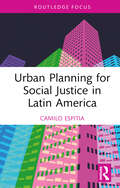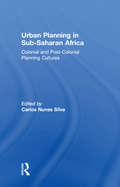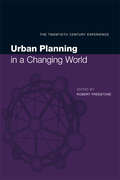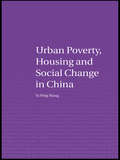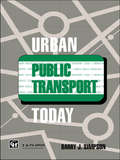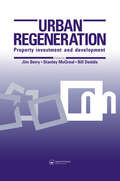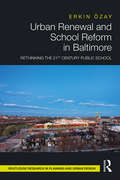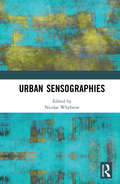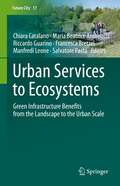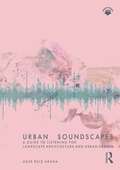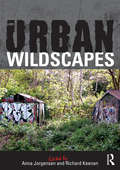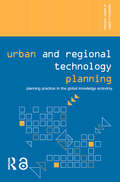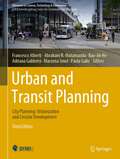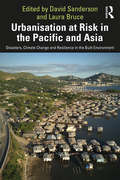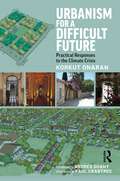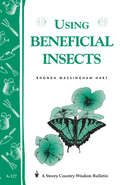- Table View
- List View
Urban Planning as a Trading Zone
by Raine Mäntysalo Alessandro Balducci'Trading zone' is a concept introduced by Peter Galison in his social scientific research on how scientists representing different sub-cultures and paradigms have been able to coordinate their interaction locally. In this book, Italian and Finnish planning researchers extend the use of the concept to different contexts of urban planning and management, where there is a need for new ideas and tools in managing the interaction of different stakeholders. The trading zone concept is approached as a tool in organizing local platforms and support systems for planning participation, knowledge production, decision making and local conflict management. In relation to the former theses of communicative planning theory that stress the ideals of consensus, mutual understanding and universal reason, the 'trading zone approach', outlined in this book, offers a different perspective. It focuses on the potentiality to coordinate locally the interaction of different stakeholders without requiring the deeper sharing of understandings, values and motives between them. Galison's commentary comes in the form of the book's final chapter.
Urban Planning for Social Justice in Latin America
by Camilo EspitiaUrban Planning for Social Justice in Latin America explores how urban planning can be used as a tool for social equity. The book examines several Latin American cities, each with specific challenges, and explores how they have gradually overcome these difficulties through policies, planning, and design, and with private/public sector coordination. The cases include: The built environment and social mobility in Bogotá; Mexico City and its difficulties with water scarcity; Addressing air quality and environmental justice in Lima; Santiago de Chile’s energy consumption and carbon footprint; Buenos Aires and the issue of urban agriculture and food security; Connectivity as a social transformation device in Medellín. The book goes beyond simply identifying the challenges and explains some of the practical day-to-day planning efforts, including interviews with staff from those municipalities, illustrations, and strategies that have been successful. As a result, this book will be helpful to planners in the region, as well as outside Latin America, because it demonstrates how fruitful results can be achieved in areas typically perceived as underdeveloped. Although based on research and data, this book offers a positive perspective on the possibilities rather than the limitations, hoping to inspire new generations of planners to pursue careers in search of social change.
Urban Planning in Sub-Saharan Africa: Colonial and Post-Colonial Planning Cultures
by Carlos Nunes SilvaCities in Sub-Saharan Africa are unequally confronted with social, economic and environmental challenges, particularly those related with population growth, urban sprawl, and informality. This complex and uneven African urban condition requires an open discussion of past and current urban planning practices and future reforms. Urban Planning in Sub-Saharan Africa gives a broad perspective of the history of urban planning in Sub-Saharan Africa and a critical view of issues, problems, challenges and opportunities confronting urban policy makers. The book examines the rich variety of planning cultures in Africa, offers a unique view on the introduction and development of urban planning in Sub-Saharan Africa, and makes a significant contribution against the tendency to over-generalize Africa’s urban problems and Africa’s urban planning practices. Urban Planning in Sub-Saharan Africa is written for postgraduate students and advanced undergraduates, researchers, planners and other policy makers in the multidisciplinary field of Urban Planning, in particular for those working in Spatial Planning, Architecture, Geography, and History.
Urban Planning in a Changing World: The Twentieth Century Experience (Studies In History, Planning, And The Environment)
by FreestoneUrban planning in today's world is inextricably linked to the processes of mass urbanization and modernization which have transformed our lives over the last hundred years. Written by leading experts and commentators from around the world, this collection of original essays will form an unprecedented critical survey of the state of urban planning a
Urban Planning in the Third World: The Chandigarh Experience (Routledge Revivals)
by Madhu SarinOriginally published in 1982 Urban Planning in the Third World is concerned with some of the critical issues underlying urban planning in the Third World. Taking the specific case of Chandigarh, planned or rather ‘designed’ by Le Corbusier as the new capital of Punjab following Partition, the author describes the development of the city, showing how concepts inherent in the master plan and the policies pursued in its implementation not merely ignored, but totally excluded a major section of the population from ‘legal’ housing and employment. The book sets a distinct theoretical framework, examining the Indian context at the time of Independence, the Western origins of the planning concepts applied in the city, and the process by which Le Corbusier finalized its master plan in a matter of days. The book also examines the social forces determining the temporary resolution of inherent conflicts in the plan and examines the growth of non-plan settlements in the city and the impact of the plan on the lives of the settlement residents.
Urban Poverty, Housing and Social Change in China (Housing and Society Series)
by Ya Ping WangEconomic reform in China has resulted in a widening gap between the rich and the poor, and urban poverty has emerged as a key factor which may affect future development. This new book examines the poverty problem in relation to housing and social changes in large inland cities, and assesses the effectiveness of recent government anti-poverty policies. The book also puts the Chinese experience in the wider context of transitional economies and discusses the similarities and differences between China and Central and Eastern European countries. The book is based on a long period of research on Chinese urban development, and benefited from several research projects conducted in Chinese cities. It is an important reference for all of those interested in housing, urban studies and social change, and is a key text for students of the Chinese economy and society.
Urban Public Transport Today
by B. Simpson Dr Barry SimpsonThis book is about how local public transport can be made a less unacceptable alternative to the private car than it is now. It is intended for officials, politicians and others interested in the land use/local transport conundrum. It is also valuable to town planners, those working for passenger transport authorities and anyone concerned with policy making and project appraisal for local public transport.
Urban Regeneration: Property Investment and Development
by Stanley McGreal Jim Berry Bill DeddisThis book provides an in-depth analysis of the role of property investment and development in the urban regeneration process. It relates the physical, economic, financial and environmental aspects of urban change and development to the realities of particular cities by case studies drawn from Britain and Europe.
Urban Renewal and School Reform in Baltimore: Rethinking the 21st Century Public School
by Erkin ÖzayUrban Renewal and School Reform in Baltimore examines the role of the contemporary public school as an instrument of urban design. The central case study in this book, Henderson-Hopkins, is a PK-8 campus serving as the civic centerpiece of the East Baltimore Development Initiative. This study reflects on the persistent notions of urban renewal and their effectiveness for addressing the needs of disadvantaged neighborhoods and vulnerable communities. Situating the master plan and school project in the history and contemporary landscape of urban development and education debates, this book provides a detailed account of how Henderson-Hopkins sought to address several reformist objectives, such as improvement of the urban context, pedagogic outcomes, and holistic well-being of students. Bridging facets of urban design, development, and education policy, this book contributes to an expanded agenda for understanding the spatial implications of school-led redevelopment and school reform.
Urban Sensographies
by Nicolas WhybrowUrban Sensographies views the human body as a highly nuanced sensor to explore how various performance-based methods can be implemented to gather usable ‘felt data’ about the environment of the city as the basis for creating embodied mappings. The contributors to this fascinating volume seek to draw conclusions about the constitution, character and morphology of urban space as public, habitable and sustainable by monitoring the reactions of the human body as a form of urban sensor. This co-authored book is centrally concerned, as a symptom of the degree to which cities are evolving in the 21st century, to examine the effects of this change on the practices and behaviours of urban dwellers. This takes into account such factors as: defensible, retail and consumer space; legacies of modernist design in the built environment; the effects of surveillance technologies, motorised traffic and smart phone use; the integration of ‘wild’ as well as ‘domesticated’ nature in urban planning and living; and the effects of urban pollution on the earth’s climate. Drawing on three years of funded practical research carried out by a multi-medial team of researchers and artists, this book analyses the presence and movement of the human body in urban space, which is essential reading for academics and practitioners in the fields of dance, film, visual art, sound technology, digital media and performance studies.
Urban Services to Ecosystems: Green Infrastructure Benefits from the Landscape to the Urban Scale (Future City #17)
by Maria Beatrice Andreucci Chiara Catalano Riccardo Guarino Francesca Bretzel Manfredi Leone Salvatore PastaThe aim of this book is to bring together multidisciplinary research in the field of green infrastructure design, construction and ecology. The main core of the volume is constituted by contributions dealing with green infrastructure, vegetation science, nature-based solutions and sustainable urban development. The green infrastructure and its ecosystem services, indeed, are gaining space in both political agendas and academic research. However, the attention is focused on the services that nature is giving for free to and for human health and survival. What if we start to see things from another perspective? Our actions shall converge for instance to turn man-made environment like cities from heterotrophic to autotrophic ecosystems. From landscape ecology to urban and building design, like bricks of a wall, from the small scale to the bigger landscape scale via ecological networks and corridors, we should start answering these questions: what are the services that are we offering to Nature? What are we improving? How to implement our actions? This book contains three Open Access chapters, which are licensed under the terms of the Creative Commons Attribution 4.0 International License (CC BY 4.0).
Urban Smellscapes: Understanding and Designing City Smell Environments
by Victoria HenshawWe see the city, we hear the city, but above all: we smell the city. Scent has unique qualities: ubiquity, persistence, and an unparalleled connection to memory, yet it has gone overlooked in discussions of sensory design. What scents shape the city? How does scent contribute to placemaking? How do we design smell environments in the city? Urban Smellscapes makes a notable contribution towards the growing body of literature on the senses and design by providing some answers to these questions and contributing towards the wider research agenda regarding how people sensually experience urban environments. It is the first of its kind in examining the role of smell specifically in contemporary experiences and perceptions of English towns and cities, highlighting the perception of urban smellscapes as inter-related with place perception, and describing odour’s contribution towards overall sense of place. With case studies from factories, breweries, urban parks, and experimental smell environments in Manchester and Grasse, Urban Smellscapes identifies processes by which urban smell environments are managed and controlled, and gives designers and city managers tools to actively use smell in their work.
Urban Soundscapes: A Guide to Listening for Landscape Architecture and Urban Design
by Usue Ruiz AranaSound and listening are intrinsically linked to how we experience and engage with places and communities. This guide puts forward a new conceptual framework of embodied affectivity that emphasises listening in urban research and design and advances new ways of knowing and making. The guide invites landscape architects and urban designers to become soundscape architects and offers practical advice on sound and listening applicable to each stage of a design project: from reading the environment to intervening on it.Urban Soundscapes foregrounds listening as an affective mediator between subjects and multispecies environments, and a vehicle to think and conceptualise environmental research and design beyond prevailing visual and human-centred modes. The guide expands landscape architects’ and urban designers’ tools and skills to assess existing soundscapes, predict how those soundscapes will be altered through their designs, consider sound as a creative and active part of the design process and envisage how users might perceive and be affected by those soundscapes as they evolve in time. The volume sits in the interface of research and practice and interweaves theoretical, methodological and creative contributions from acoustic ecology, ecoacoustics, bioacoustics and sound art. Each of the design stages is illustrated through project examples that demonstrate the many advantages of incorporating attentive listening and sound into Landscape Architecture and Urban Design Practice. This book shows how incorporating listening and sounding as part of the design process promotes slow and subtle ways of practice, adds social and ecological value through the reduction of noise pollution and by monitoring the health of habitats, and enables the design of soundscapes that complement the character and design intent of a scheme and elicit joy and wonder.The book will be of interest to practitioners and academics in landscape architecture, and other design and spatial fields such as urban design, architecture, geography and engineering, who play a primary role in the composition of the soundscape.
Urban Structure Matters: Residential Location, Car Dependence and Travel Behaviour (RTPI Library Series)
by Petter NaessGoing beyond previous investigations into urban land use and travel, Petter Næss presents new research from Denmark on residential location and travel to show how and why urban spatial structures affect people's travel behaviour. In a comprehensive case study of the Copenhagen metropolitan area, Næss combines traditional quantitative travel surveys with qualitative interviews in order to identify the more detailed mechanisms through which urban structure affects travel behaviour. The case study findings are compared with those from other Nordic countries and analyzed and evaluated in the light of relevant theory and literature to provide solid, valuable conclusions for planning sustainable urban development. With a broader range of statistics than previous studies and conclusions of international relevance, Urban Structure Matters provides well-grounded conclusions for how spatial planning of urban areas can be used to reduce car dependence and achieve a more sustainable development of cities.
Urban Surfaces, Graffiti, and the Right to the City (ISSN)
by Sabina AndronThis book explores the ownersheir authorship and management, and their role in struggles for the right to the city. Includes a critical history of graffiti and street art as contested surface discourses. Interdisciplinary appeal.
Urban Sustainability Through Environmental Design: Approaches to Time-People-Place Responsive Urban Spaces
by Kevin Thwaites Sergio Porta Ombretta Romice Mark GreavesWhat can architects, landscape architects and urban designers do to make urban open spaces, streets and squares, more responsive, lively and safe? Urban Sustainability through Environmental Design answers this question by providing the analytical tools and practical methodologies that can be employed for sustainable solutions to the design and management of urban environments. The book calls into question the capability of ‘quick-fix’ development solutions to provide the establishment of fixed communities and suggests a more time-conscious and evolutionary approach. This is the first significant book to draw together a pan-European view on sustainable urban design with a specific focus on social sustainability. It presents an innovative approach that focuses on the tools of urban analysis rather than the interventions themselves. With its practical approach and wide-ranging discussion, this book will appeal to all those involved in producing communities and spaces for sustainable living, from students to academics through to decision makers and professional leaders.
Urban Wildscapes
by Anna Jorgensen Richard KeenanUrban Wildscapes is one of the first edited collections of writings about urban ‘wilderness’ landscapes. Evolved, rather than designed or planned, these derelict, abandoned and marginal spaces are frequently overgrown with vegetation and host to a wide range of human activities. They include former industrial sites, landfill, allotments, cemeteries, woods, infrastructural corridors, vacant lots and a whole array of urban wastelands at a variety of different scales. Frequently maligned in the media, these landscapes have recently been re-evaluated and this collection assembles these fresh perspectives in one volume. Combining theory with illustrated examples and case studies, the book demonstrates that urban wildscapes have far greater significance, meaning and utility than is commonly thought, and that an appreciation of their particular qualities can inform a far more sustainable approach to the planning, design and management of the wider urban landscape. The wildscapes under investigation in this book are found in diverse locations throughout the UK, Europe, China and the US. They vary in scale from small sites to entire cities or regions, and from discrete locations to the imaginary wildscapes of children’s literature. Many different themes are addressed including the natural history of wildscapes, their significance as a location for all kinds of playful activity, the wildscape as ‘commons’ and the implications for landscape architectural practice, ranging from planting interventions in wildscapes to the design of the urban public realm on wildscape principles.
Urban and Regional Technology Planning: Planning Practice in the Global Knowledge Economy (Networked Cities Series)
by Mark Wilson Kenneth E. CoreyPart of the popular Networked Cities series, Urban and Regional Technology Planning focuses on the practice of relational planning and the stimulation of local city-regional scale development planning in the context of the global knowledge economy and network society. Designed to offer scholars, practitioners, and decision makers studies on the ways of cities, technologies, and multiple forms of urban movement intersect and create the contemporary urban environment, Kenneth Corey and Mark Wilson explore the dynamics of technology-induced change that is taking place within the context of the global knowledge economy and network society. Examining first the knowledge economy itself, Wilson and Corey go on to discuss its implications before proposing ways to strategize for future intelligent development, with particular emphasis on the ALERT model for regional and local planning. An important read for those practicing or studying planning in this network society.
Urban and Transit Planning (Advances in Science, Technology & Innovation)
by Simon Elias Bibri Francesco Alberti Abraham R. Matamanda Paola Gallo Cristina Piselli Hamid Rabiei Rosa Romano Ayse Ozcan BuckleyThis book explores aspects of creating cities and structures with a focus on sustainability. It provides an analysis of contemporary methodologies, technologies, and principles essential for designing urban environments and buildings that significantly reduce environmental impact. Moreover, it emphasizes the importance of energy efficiency, resource conservation, and the integration of green spaces to enhance the quality of life for urban dwellers. Covering a broad spectrum of topics, from sustainable urban mobility to green architecture and smart city initiatives, this book serves as an invaluable resource for professionals, researchers, and students. Furthermore, it aims to inspire and guide those dedicated to developing a sustainable future through innovative and responsible urban planning and architectural design practices.
Urban and Transit Planning: City Planning: Urbanization and Circular Development (Advances in Science, Technology & Innovation)
by Francesco Alberti Abraham R. Matamanda Paola Gallo Adriana Galderisi Bao-Jie He Marzena SmolThis book represents a compilation of research in sustainable architecture and planning. Its main focus is offering strategies and solutions that help reducing of the negative impacts of buildings on the environment and emphasizing the suitable management of available resources. By tackling the topic of sustainability from a historical perspective and also as a vision for the future, the book in hands provides new horizons for engineers, urban planners and environmentalists interested in the optimization of resources, space development, and the ecosystem as a whole to address the complex unresolved problems our cities are facing. This book is a culmination of selected research papers from IEREK’s sixth edition of the International Conference on Urban Planning & Architectural Design for Sustainable Development (UPADSD) held online in collaboration with the University of Florence, Italy (2021) and the first edition of the International Conference on Circular Economy for Sustainable Development (CESD) held online in collaboration with the University of Salento, Lecce, Italy (2021).
Urban and Transit Planning: Towards Liveable Communities: Urban places and Design Spaces (Advances in Science, Technology & Innovation)
by Eric Strauss Yasser Mahgoub Francesco Alberti Paola Gallo Mourad Amer Adriana GalderisiThis book incorporates a wealth of research focused on the more and more urgent challenges that urban planning and architectural design all over the world must cope with: from climate change to environmental decay, from an increasing urban population to an increasing poverty. In detail, this book aims at providing innovative approaches, tool and case study examples that, in line with the agenda of 2030, may better drive human settlements toward a sustainable, inclusive and resilient development. To this aim, the book includes heterogeneous regional perspectives and different methodologies and suggests development models capable of limiting further urban growth and re-shaping existing cities to improve both environmental quality and the overall quality of life of people, also taking account the more and more close relationships among urban planning and technological innovation.
Urbanisation at Risk in the Pacific and Asia: Disasters, Climate Change and Resilience in the Built Environment
by David Sanderson Laura BruceThis book presents practical approaches for tackling the threats from climate change and disasters to urban growth in Pacific island countries and Asian nations. With chapters written by leading scholars and practitioners, Urbanisation at Risk presents research and case studies from island countries across the Pacific, Cambodia, Nepal and the Philippines. The book explores and presents the theory, policy and practice of how governments, civil society, aid organisations and people themselves prepare for, withstand and recover better from urban disasters including windstorms, floods, earthquakes and fires, and the effects of climate change. This book is written for urban policy makers, researchers, humanitarian aid and development workers, and anyone interested in urbanisation, participatory approaches, disasters, resilience and climate change adaptation.
Urbanism for a Difficult Future: Practical Responses to the Climate Crisis
by Korkut OnaranUrbanism for a Difficult Future: Practical Responses to the Climate Crisis is a much-needed guide to launching the next generation of land use planning and urbanism that will enable us to adapt to and survive the consequences of climate change. The book offers strong, straightforward measures for creating a landscape of resilience via pockets of self-sufficiencies. It demonstrates how to secure systems that sustain life (energy, water, food, waste, and production of essential goods) as well as political and social protocols enabling agile decision-making in managing these systems effectively at local levels. It also provides the design principles for creating a built environment that will enable the kind of localization we need for adaptation. The book explores how it is possible to create a life that does not depend on large-scale regional sustenance systems which are likely to be disrupted or fail. This book uncovers how to enable people to be creative, productive, and supportive at local levels, so that we can achieve strong and diverse local economies that can sustain life. It will appeal to students, planners, and policy makers working in environmental studies, environmental engineering, urban and regional planning, architecture, landscape architecture, and urbanism.
Using Beneficial Insects: Storey's Country Wisdom Bulletin A-127 (Storey Country Wisdom Bulletin Ser.)
by Rhonda Massingham HartSince 1973, Storey's Country Wisdom Bulletins have offered practical, hands-on instructions designed to help readers master dozens of country living skills quickly and easily. There are now more than 170 titles in this series, and their remarkable popularity reflects the common desire of country and city dwellers alike to cultivate personal independence in everyday life.
Using Collective Impact to Bring Community Change (Community Development Research and Practice Series)
by Norman Walzer Liz WeaverCollective Impact as a tool to bring about community change has seen remarkable growth in usage since 2011. Collective Impact has been used successfully with a variety of local issues and has raised the consciousness of how community groups interact as well as the approaches that can lead to long-term innovations. This edited volume sets forth conceptual foundations for using Collective Impact as well as sharing basic approaches that have succeeded in projects under diverse circumstances. It will be useful for both academics and practitioners as Collective Impact continues to undergo substantial changes in focus and direction. Building on Kania and Kramer’s influential work, it provides readers with detailed insights not only into how the Collective Impact system works but also innovative applications to issues facing community developers. The diverse topics shared by the contributing authors make this volume especially important for practitioners designing programs to bring about long-term changes in their communities. Including discussion about how Collective Impact has succeeded in different governmental settings, this book demonstrates how Collective Impact has been modified to accommodate the associated cultural differences with 10 chapters written by experienced on-the-ground community development experts.

